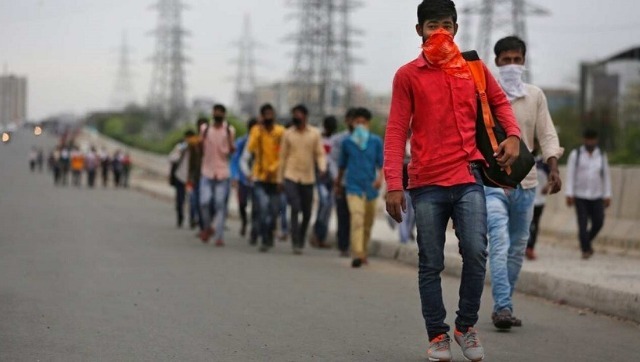Of the many enduring images during the ongoing COVID-19 crisis, the multiple visuals of migrant workers scrambling home on foot, cycle, hidden in cement mixing trucks , and desperately thronging public transport platforms in the false hope of a ride, have seared urban India’s consciousness.
It is these migrant workers who make the lives of the urban middle class and the relatively affluent across India transition seamlessly from one day to another by cooking, repairing, cleaning, delivering groceries — earning at best a passing reference in mainstream news media and popular culture. Over the decades, many of them have made cities their permanent residence, but millions of these people are the only remaining bridge between urban India and rural Bharat. Many lead twin lives: one surviving on the crumbs of urban prosperity and the other in the morasses of their rural dwelling, in a part of India that is teeming with “disguised unemployment”.
As the migrant crisis slowly subsides and India crawls its way back to normalcy, this is the right time to ask: isn’t there a way to avoid forcing these individuals out of their homes?
Rural India has traditionally survived on agriculture and allied activities. With 118.9 million people engaged in farming, the sector provides livelihood to 24.6 percent of the total workforce in India of over 481 million; add agricultural labour, the percentage is more than 50 percent. Yet the contribution of agriculture is less than 20 percent of India’s GDP . Sixty-seven percent of those engaged in farming are small landholders with less than a hectare of land. These families practice subsistence agriculture which does not meet their year-round needs. Farming incomes , in real terms, have stagnated over the last few years whereas costs of production have significantly gone up.
A vast majority of these marginal farmers live in concentrated rural pockets in several states, particularly in the Hindi heartland and from Eastern and Central parts of India. These pockets are characterised by extreme poverty and deprivation with a very high percentage of the population in the Below Poverty Line (BPL) category. Several factors contribute to the entrenched nature of poverty in these geographies: lack of diversification of livelihoods, lack of marketable surplus as well as underdeveloped market linkages, history of militancy and ethnic clashes, difficult terrain, little farm mechanisation and absence of coordinated effort among different stakeholders to address issues of poverty and inequity.
Consequently these are the areas that see large scale seasonal distress migration across the country in search of work. The Census of 2011 puts the number of internal migrants to be 450 million, or about 37 percent of the population. While majority of these are intra-state, about 12 percent is inter-state. In the last decade since the Census of 2011, this number is bound to spike with increased mobility of rural migrants in search of livelihoods to more prosperous urban centres. Needless to say, a vast majority of them are from the low income category : the poorest and those on the thresholds. The sector-wise major employment of migrant workers falls in the categories of: construction (40 million), domestic work (20 million), textiles (11 million) and brick kilns (10 million).
Different types of people migrate from our villages: small landholders, landless, post-farming season migrants and youth (a small percentage of this young population also comprises school-educated, semi-skilled workers). Increasingly, more and more of these youth are flocking to the cities looking for better opportunities. If each village was a country, the internal migration from India’s poorest areas could be compared to the flight of Indians abroad in search for better opportunities in the last 200 years: a large section of the unskilled would be heading to worksites ranging from Middle East to the Caribbean (to work in construction, large farms, plantation etc.) with a small section of young skilled workers heading to the relatively affluent Western countries (to work in sales, hospitability etc.). While this analogy is far from apt, it does give an idea of a very broad categorisation of the internal migrants from India’s poorest villages.
This migration while proving to be a essential cog in the running of these village economies through remittances, deprives these economically backward areas of a small but crucial percentage of school educated, smart, technology exposed young people (not very dissimilar from India’s situation for many decades after independence). In the aftermath of COVID-19, most of these young migrants have returned to their villages with few prospects of going back [to the cities> in the near future and without many opportunities in their current environment.
Migration in search of livelihoods will continue from the economically deprived parts of India to the more prosperous areas of the country over the foreseeable future. There is, in fact, a strong case for providing social security and support to migrants in the states where they work. However, can an opportunity emerge from the current pandemic to revive and reboot rural economies? What could possibly be the solution to lack of critical surplus production in many remote areas with underdeveloped market linkages and trapped youths with some skills and relatively better education? Can the vast social base of women’s Self Help Groups (SHGs) promoted under the government flagship programme, the National Rural Livelihoods Mission (NRLM), and multiple NGOs working in the sector also come into the picture? Can an inter-sectorial alliance facilitate the emergence of prosperous clusters of rural areas?
We think it is possible — but will require systemic changes and building diverse collaborations to create enabling conditions for social entrepreneurship in villages. We need to bring together two social extremities in the rural people-scape: some of the educated returning migrants who are comfortable with technology, and the collective strength of women from marginalised groups, who are now the major contributors in rural livelihoods. Now is the right time to tap into this pool of young change leaders in the community to build an enabling culture of vibrant entrepreneurship in these areas, to reboot the rural economy.
Five aspects will be critical for an initiative of this nature:
1. Identify geographical clusters of rapid distress migration
Reinvigorating the rural economy will happen only when multiple large geographies with shared cultural, economic and agro-ecological contexts come together towards a common goal of working on multiple nodes of value chains. These areas, known as Innovation Pockets (IPs), should have predefined “production of farm and off-farm commodity” for synchronisation of individual farmers, mapping of production activities of the particular crop and time schedule for monitoring. Particular commodities should integrate local production systems with market potential.
2. Build a broad coalition of stakeholders
The functioning of each IP should be a joint partnership of communities, relevant government line departments, NGOs, business houses and investors. Different government schemes such as NRLM, National Rural Economic Transformation Project, National Rural Employment Guarantee Act, 2005 (Ministry of Rural Development), Micro-entrepreneur scheme (Ministry of Food Processing Industries); agencies (like NABARD and SFAC); and finances from banks, micro-finance and venture capitalists will bring the required technical expertise, financial resources and linkages to remote villages.
3. Motivate young returnee migrants to be aspirational
Enabling conditions should be created to retain these Youth Migrant Entrepreneurs (YMEs) who are school educated and comfortable with technology to earn higher incomes by helping them set up their micro-enterprise and supporting their training in premier national institutions for social entrepreneurship promotion in India.
4. Aggregation and packaging through community organisations
For generation of sufficient volumes of specific commodities, the collective strength of women SHGs (and Farmers Producers Organisations) promoted by NRLM and NGOs should be tapped in to reach “economy of scales”. The complex problem of “the middlemen” can be resolved by the use of processing technology for commodities to have longer shelf lives and easily reach different markets. It might also nudge a large chunk of underserved areas towards a formal economy.
5. Use Artificial Intelligence-based technology
FPOs will support farmers’ access to technological intervention in the form of package of practices (PoPs), agriculture input linkages and “precision agriculture” to support productivity, as well Internet of Things (IoT) for traceability, so that the consumer is aware of the product’s journey from farm to plate. Organic and ethical production with tracebility would be the hallmark of products that will be packaged and branded by the FPOs. Enhanced production will also be absorbed by the local unmet primary market (resulting in lower carbon footprints). Investment in technology with a strong FPO social base will also prepare the country to withstand the uncertain impacts of climate change.
How a broad alliance of this nature will work is another complex question, as is the larger question of “who will fund this?”. While an initiative of this nature will eventually be self-sustaining, it will require an initial impetus of a few years. Could CSR funds play a part? Would venture capitalists pick up one of the geographies for investment? What would be the government’s share?
Some existing old models can serve as guiding principles for a transformative engagement of this nature: Amul’s model of aggregation, Kudumbasree’s model of micro-finance support to a large social base of poor women, and Buddha Fellowships that tag IIM/IIT graduates to work with rural entrepreneurs. However, this initiative will require a much bigger and bolder investment and intersectorial collaboration in different poverty pockets in the country. Only then perhaps, will the ingenuity and collective strength of this section of the populace become the pillars of a rebooted rural economy and in turn accelerate the revitalisation of India’s economy.
Achintya is the founder of the NGO Kabil and former executive director of PRADAN. Chandan has over 10 years of work experience in rural India and is currently associated with Seven Sisters Development Assistance, which has a presence across rural North East India. Ved is founder — Srijan, one of India’s largest rural NGOs, and leads the Buddha Fellowship.


)




)
)
)
)
)
)
)
)